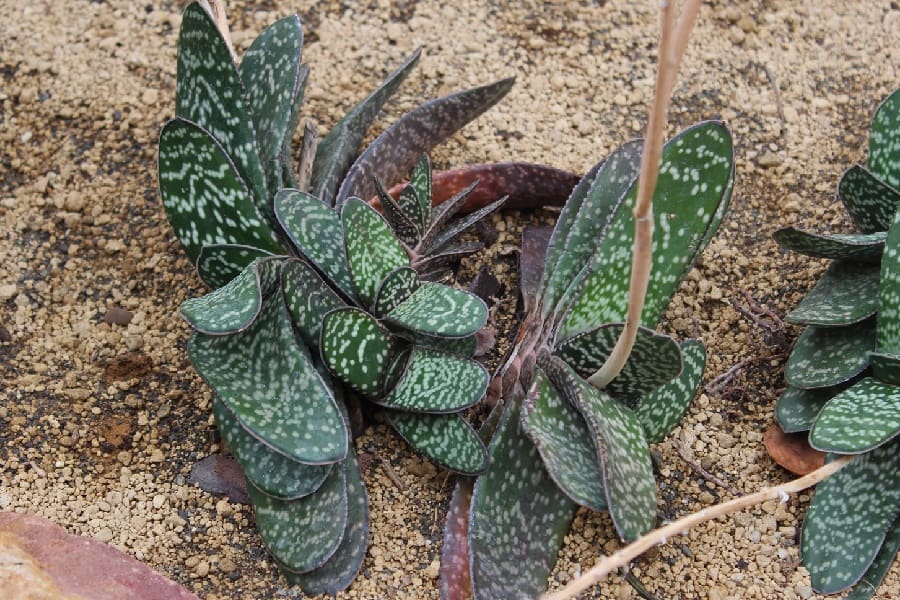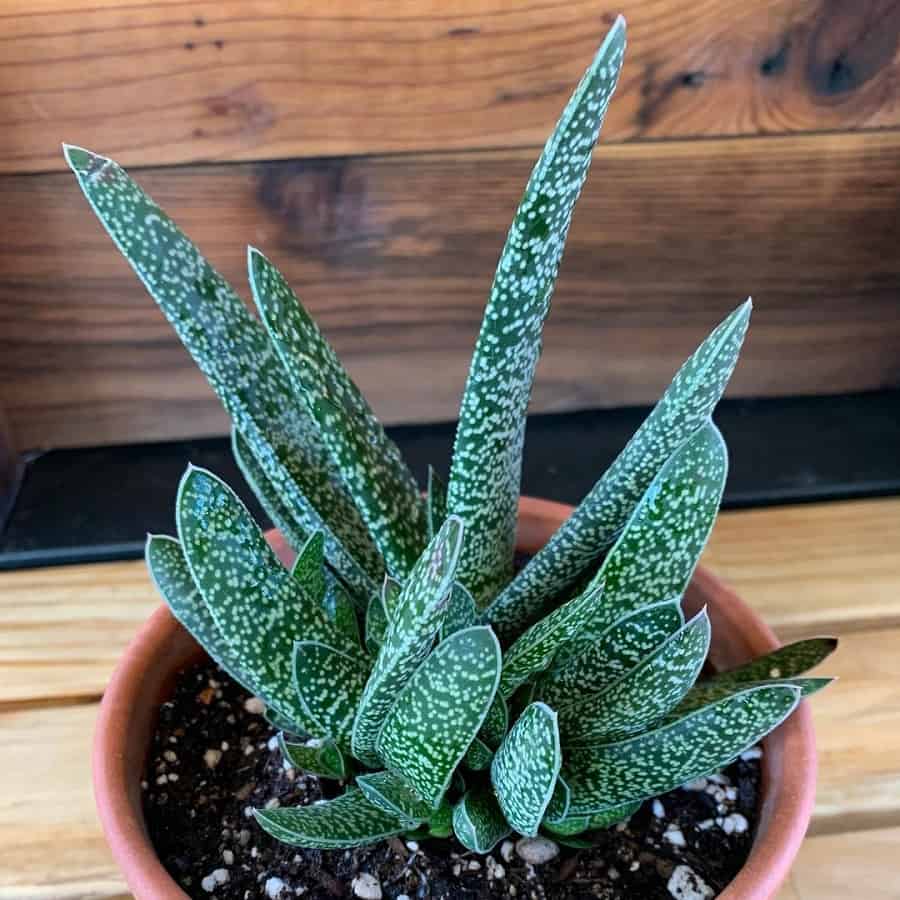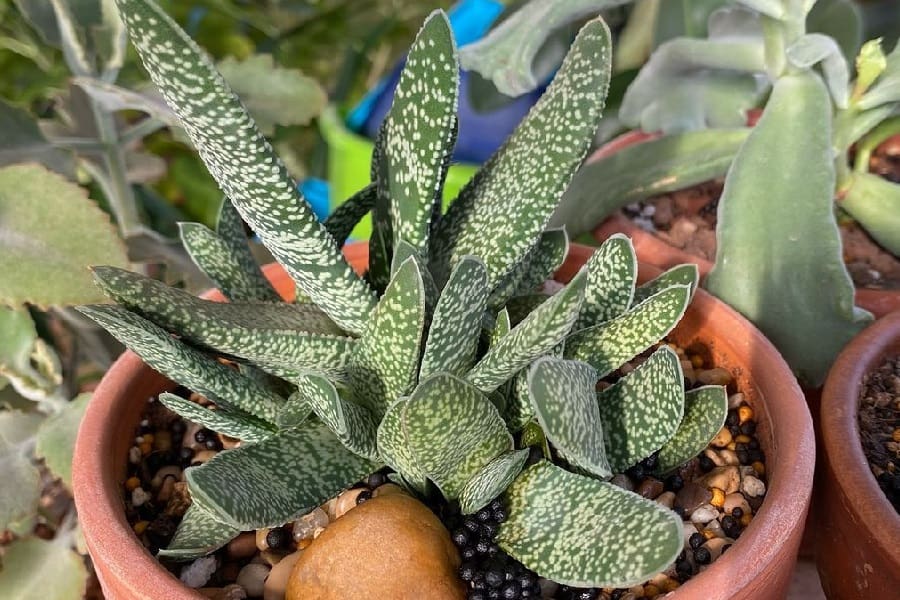The Speckled Beauty: Gasteria maculata Uncovered
Feast your eyes on the captivating Gasteria maculata, a true showstopper in the world of succulents! With its striking fan-like clusters of speckled leaves, this South African native is sure to steal the spotlight in any indoor or outdoor setting. Get ready to unravel the secrets of this speckled sensation and unlock its full potential for your very own garden oasis.

Contents
About Gasteria maculata
Also known as the “Spotted Pig’s Ear” or “Ox Tongue,” Gasteria maculata boasts dark green leaves adorned with mesmerizing yellowish-white spots that seem to dance across their surfaces. These long, narrow leaves grow from multiple stems, occasionally forming a captivating rosette pattern. When the flowers bloom, they emerge on a separate 12-inch (30 cm) long stem, showcasing breathtaking pink and orange bell-shaped blossoms that are sure to turn heads.
Related Post:
33 Types of Gasteria Succulents With Pictures
How to Care for Gasteria maculata
Light Requirements
While Gasteria maculata thrives in bright, indirect light, it’s surprisingly adaptable to various lighting conditions. If you plan to grow it indoors, place it near a sunny window or consider using a grow light to ensure it receives ample illumination. Outdoors, partial shade is ideal, as direct, all-day sunlight can be too intense for this beauty. Gradually introduce your plant to sunlight after its dormancy period to prevent leaf burn.
Watering Needs
Like most succulents, Gasteria maculata appreciates a “sip as you go” approach to watering. During the summer months, provide moderate watering every 10 to 15 days, allowing the soil to dry out completely between waterings. In the winter, reduce watering to once a month at most. Overwatering is a surefire way to invite root rot, so always err on the side of caution.
Soil Preferences

Choosing the right soil mix is crucial for Gasteria maculata’s success. This speckled stunner prefers a well-draining, porous soil that allows excess moisture to escape quickly. Look for a high-quality succulent soil mix or create your own blend by combining potting soil with peat, sand, perlite, and limestone. Ensure your container has ample drainage holes to prevent water from pooling and causing root rot.
Fertilizer Recommendations
To keep your Gasteria maculata thriving, feed it with a succulent-specific fertilizer every 2-3 weeks during the growing season. Look for a formula rich in potassium and low in nitrogen, and consider diluting it with water for a slow-release effect. This will provide your plant with the essential nutrients it needs without overwhelming its delicate system.
Temperature and Humidity
Gasteria maculata is a resilient beauty that can handle a wide range of temperatures and humidity levels. It thrives in warm conditions, with a minimum temperature of around 40°F (4°C). In warmer weather, you may notice the leaves taking on a brighter, more vibrant hue or even the plant producing its stunning sack-shaped blooms.
Pests and Problems
While generally trouble-free, Gasteria maculata can occasionally fall victim to common succulent pests like mealybugs and aphids. These pesky critters often indicate that your plant isn’t receiving enough light. Combat them with a gentle insecticidal soap or rubbing alcohol solution. Additionally, small black spots may appear on the leaves, but fear not – these harmless blemishes won’t spread or damage your plant.
Pruning and Maintenance
Gasteria maculata is a low-maintenance beauty that requires no pruning. However, it’s a good idea to remove any dead or damaged leaves to maintain its tidy appearance and prevent the spread of disease.
Potting and Repotting
To keep your Gasteria maculata happy and healthy, it’s recommended to repot it annually in the spring. This succulent generates new roots each year, and the old ones tend to die off. Repotting allows you to remove the old, tangled roots, ensuring that water and nutrients can reach the plant more efficiently.
Gasteria maculata Propagation Methods
Gasteria maculata is an incredibly prolific plant, offering multiple methods for propagation. Whether you prefer offsets, leaf cuttings, or growing from seed, this speckled beauty makes it easy to expand your collection or share with fellow plant enthusiasts.

Offsets
One of the simplest and most common methods is propagating via offsets or “pups.” In the spring, keep an eye out for these tiny plantlets emerging from the base of the mother plant.
- Gently separate offsets with roots attached using a sharp, sterile knife or scissors.
- Plant offsets in a well-draining cactus or succulent potting mix.
- Water sparingly until new growth appears and offsets are established.
Leaf Cuttings
You can also propagate Gasteria maculata from healthy leaf cuttings. This method takes a bit more patience but is highly rewarding.
- Use a clean, sharp blade to remove a leaf from the mother plant.
- Allow the cut end to callus over for a few days.
- Lay the leaf on top of a well-draining soil mix and secure with a rock or plant stake.
- Keep the soil lightly moist and provide bright, indirect light.
- New plantlets will eventually emerge from the leaf.
Seeds
For those feeling adventurous, Gasteria maculata can also be grown from seed. However, this method requires a bit more effort and time.
- Sow seeds in a sterile seed-starting mix and cover lightly with soil.
- Keep the soil consistently moist but not waterlogged.
- Provide bright, indirect light and warm temperatures around 70-80°F (21-27°C).
- Once seedlings appear, transition to a fast-draining succulent mix as they mature.
No matter which propagation method you choose, Gasteria maculata’s ease of reproduction ensures you’ll have plenty of speckled beauties to admire and share for years to come.
